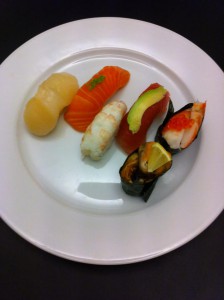There are 5 different types of Japanese sushi.
Uramaki
Most people have encountered uramaki. It is a sushi roll which is available in one size. Sushi seaweed and the filling are inside the roll, while there is rice on the outside of the roll. In Japan, sushi restaurants sprinkle sesame seeds on the rice that covers the roll.
Maki
In Europe, maki is the most popular sushi rolls. In Europe you can order maki in 2 different sizes. Hosomaki is the smallest roll it is characterized by having filling in the roll. The sushi seaweed is on the outside of the sushi roll.
Futomaki is the big roll. It is a roll with several different kinds of ingredients, ranging from fish to different kinds of vegetables. To keep all the ingredients in place, sushi seaweed is wrapped tightly around the roll.
Temaki
In Europe, temaki is not so widespread. In Japan, there is a roll served in restaurants. It is a roll that looks like a cone with different kinds of fillings. Abroad, it goes by the name of hand rolls.
Sashimi
In Europe, sashimi is eaten to a lesser extent. It is fish without rice and vegetables. In Japan, sashimi is very common. It is at least as popular as the other types of sushi. In Japan, fish is cut in many different ways and the dish is served in several different ways.
Nigiri
Nigiri is fish with rice. In Japan, nigiri is very common. There are typically 20 different fish on the menu in Japanese sushi restaurants. There are many Japanese in Tokyo who choose to eat nigiri only when visiting a sushi restaurant. That way, they get to taste several different kinds of fish.
At the Sushi course for beginners, you learn that you can make tasty that can be served for everyday and occasions.
_
Zoë has lectured and held sushi courses for A. P. Moller – Maersk, Hugo Boss Nordic, Novo Nordisk, Novartis, Velux, Gorrissen Federspiel, Beierholm revision, Elbek & Vejrup and many more.








